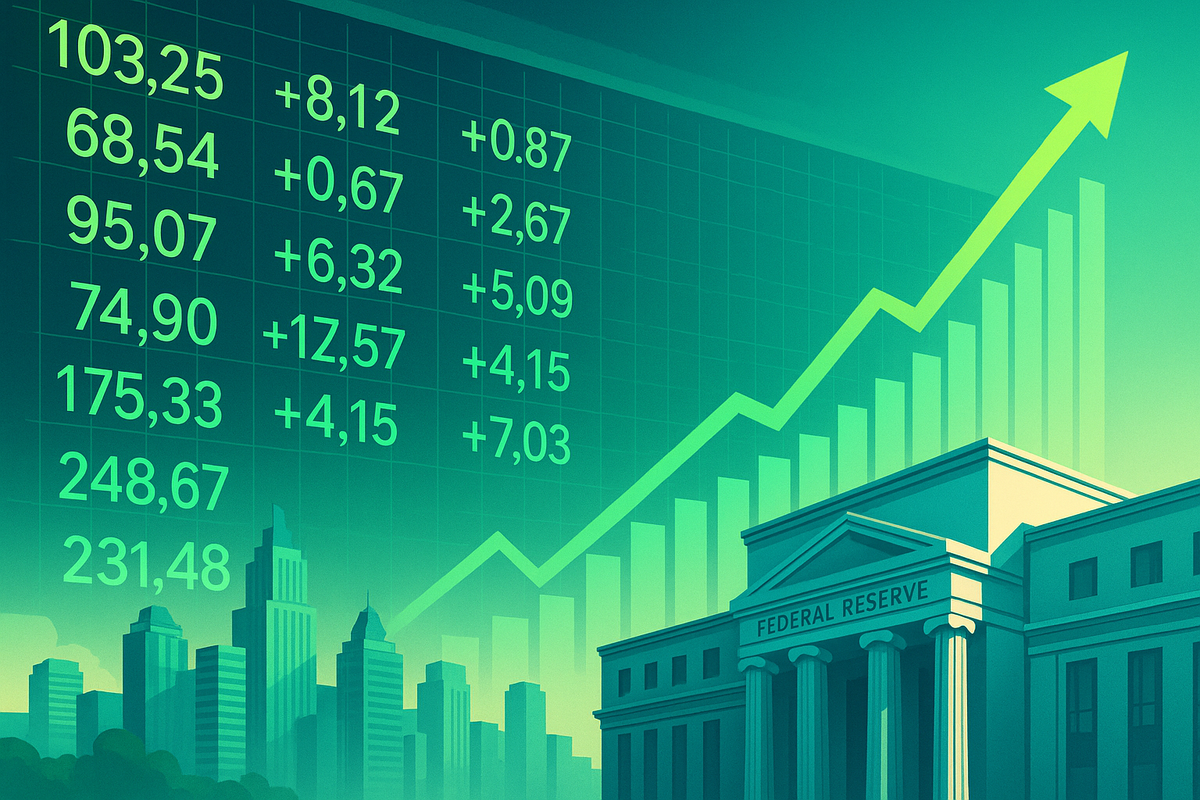
Wall Street erupted in a broad market rally on Wednesday, August 13, 2025, as both the S&P 500 and Nasdaq Composite surged to new all-time highs. This significant upward trend was primarily fueled by burgeoning optimism surrounding potential Federal Reserve interest rate cuts, a sentiment bolstered by recent easing inflation data. Investors are now eagerly anticipating a more accommodative monetary policy, which is seen as a powerful catalyst for economic growth and corporate profitability.
The immediate implication for investors is a continuation of the bullish momentum, particularly in growth-oriented sectors. For the broader economy, the anticipated rate cuts are expected to stimulate borrowing and spending, potentially leading to increased investment and job creation. However, the market's exuberance is tempered by underlying complexities, including persistent core inflation and the ongoing impact of trade tariffs, which present a nuanced picture for the Federal Reserve's path forward.
A Historic Ascent: What Happened and Why It Matters
Wednesday, August 13, 2025, marked a pivotal day for the U.S. stock market, with major indices not only reaching but surpassing previous record highs. The S&P 500 (SPX) climbed an impressive 1.1% to close at 6,445.76, setting a new closing record and touching an intraday all-time high of 6,446.55. Not to be outdone, the technology-heavy Nasdaq Composite (IXIC) rallied 1.4%, finishing at 21,681.90, also establishing new closing and intraday all-time highs of 21,689.68. Even the Dow Jones Industrial Average (DJIA) joined the ascent, rising 1.1% or nearly 500 points, nearing its own record high set in December 2024. This marked the second consecutive day of record highs for both the S&P 500 and Nasdaq, signaling robust market confidence.
The primary catalyst for this widespread rally was the July Consumer Price Index (CPI) report, released just the day before, on Tuesday, August 12, 2025. The report indicated that headline inflation had eased to 2.7% year-over-year, a figure slightly below economists' projections. While core inflation, which excludes volatile food and energy prices, did tick up to 3.1%—its highest annual pace in five months—market participants largely interpreted the overall data as a "Goldilocks" scenario. This suggests that inflation is cooling enough to justify a rate cut by the Federal Reserve, without signaling an imminent economic slowdown.
This inflation data significantly reinforced market expectations that the Federal Reserve would initiate interest rate cuts as early as its next Federal Open Market Committee (FOMC) meeting in September. Fed fund futures now indicate a near 95% probability of a rate cut in September, a substantial increase from less than 60% just a month prior. Adding to the chorus of calls for easing, U.S. Treasury Secretary Scott Bessent explicitly advocated for a half-point interest rate reduction in September and suggested a series of subsequent cuts, stating that the central bank's benchmark rate should be at least 1.5 percentage points lower than its current range of 4.25% to 4.5%. The prospect of lower borrowing costs is inherently beneficial for the stock market, as it reduces the cost of capital for businesses, potentially stimulating investment, boosting corporate earnings, and encouraging consumer spending. This sentiment has fostered a "risk-on" environment, prompting investors to allocate more capital towards riskier assets like equities.
Winners and Losers in a Rate-Cut Environment
The prospect of Federal Reserve interest rate cuts creates a distinct landscape of winners and losers across the financial markets, primarily by altering borrowing costs and influencing consumer and business spending patterns. Sectors that are highly sensitive to interest rates or rely heavily on consumer financing are poised for significant gains, while others may face headwinds.
Among the most prominent beneficiaries are Real Estate and Homebuilding companies. Lower interest rates directly translate to more affordable mortgage rates, which in turn boosts demand for housing and fuels construction activity. Homebuilders like Lennar (NYSE: LEN) and D.R. Horton (NYSE: DHI) are expected to see increased sales and profitability as more prospective homeowners enter the market. Similarly, Real Estate Investment Trusts (REITs), such as Welltower (NYSE: WELL), benefit from reduced borrowing costs for property acquisitions and development, enhancing their returns on investment.
The Consumer Discretionary sector is also set to thrive. With lower borrowing costs, consumers have more disposable income and find it cheaper to finance big-ticket purchases like automobiles, appliances, and home improvements. This surge in consumer spending directly benefits companies selling luxury goods or durable goods, such as Ralph Lauren (NYSE: RL).
Technology and Semiconductors are another major winning sector. Tech companies often require substantial capital for research and development (R&D), innovation, and expansion. Lower interest rates reduce their cost of capital, making it more attractive to invest in growth opportunities. Furthermore, lower discount rates used in valuation models can lead to higher stock valuations for growth-oriented tech companies, as their future cash flows are valued more highly in present terms. Major players like Nvidia (NASDAQ: NVDA), Apple (NASDAQ: AAPL), and Tesla (NASDAQ: TSLA), which rely on significant investment and can see their valuations boosted by lower discount rates, are likely beneficiaries.
Conversely, certain sectors and entities may face challenges. Savers and Fixed-Income Investors are likely to be among the losers. Lower interest rates directly translate to diminished returns on savings accounts, certificates of deposit (CDs), and money market accounts. Individuals and institutions relying on interest income from these conservative investments will see their earnings decline. Similarly, new bonds issued in a lower-rate environment will offer lower yields, making them less attractive to income-focused investors.
While financial institutions can see increased loan demand, a primary challenge for banks is the compression of Net Interest Margins (NIM). When the Federal Reserve cuts its benchmark rate, the interest banks earn on loans tends to fall faster than the interest they pay on deposits, squeezing their profitability. The Insurance Sector, particularly companies with long-duration liabilities, can also be adversely affected. Lower interest rates reduce the present value of their future cash flows, impacting their profitability and the returns on their investment portfolios, which often consist of fixed-income securities.
Industry Impact and Broader Implications
The stock market rally, propelled by the anticipation of Federal Reserve rate cuts, signifies a profound shift in monetary policy and carries extensive implications for the economy, various industries, and the regulatory landscape. This event reflects a renewed sense of optimism among investors, signaling a potential pivot towards a more accommodative economic environment after a period of aggressive monetary tightening.
The wider significance of this rally lies in the expected stimulation of economic activity. Lowering the federal funds rate makes borrowing cheaper for both consumers and businesses. For consumers, this translates to more affordable loans for homes, cars, and credit cards, potentially increasing disposable income and driving consumer spending, a key engine of economic growth. For businesses, reduced borrowing costs can lead to increased investments in infrastructure, expansion, and hiring, boosting productivity and job creation. This environment typically makes fixed-income investments like bonds less attractive, as their yields decline, prompting investors to shift towards equities, which can push up stock prices. A weaker dollar, often a consequence of lower interest rates, can also make U.S. exports more competitive internationally.
This current market rally fits into a broader industry trend of adapting to evolving monetary policy, shifting from a period of aggressive rate hikes to combat inflation towards potential easing to foster economic growth. Industries particularly sensitive to interest rates are poised to benefit significantly. This includes Real Estate and Housing, where lower mortgage rates make home buying more affordable, stimulating demand and potentially increasing home sales and prices. Technology companies, especially those benefiting from AI-driven growth, are also set to thrive as lower borrowing costs fuel increased investment in research and development, accelerating innovation and intensifying competition. The rally is significantly fueled by the performance of large technology companies, leading to a concentration of market capitalization within the tech sector. Consumer Discretionary and Industrials are also expected to benefit from increased consumer spending. Furthermore, Small-Cap Companies, which often carry more debt and are more sensitive to interest rate changes, stand to gain significantly from reduced borrowing costs, leading to greater earnings improvement.
The anticipated rate cuts can create significant ripple effects on competitors and partners across industries. Lower borrowing costs make it easier for companies to secure funding for innovation and expansion, potentially intensifying competition. Easier access to capital could also lead to increased Mergers & Acquisitions (M&A) activity as larger players seek to acquire promising startups or consolidate market share. Companies with higher debt loads or those planning significant capital expenditures will be more sensitive to changes in borrowing costs, potentially leading to a divergence in investment strategies. While generally positive for the economy, lower rates can be a "double-edged sword" for banks and lenders, as they earn less on loans, potentially leading to tighter lending practices, especially for riskier sectors or businesses with limited credit histories.
Regulatory bodies and policymakers will closely monitor several factors. While rate cuts aim to stimulate growth, they can also lead to inflationary pressures if economic activity is stimulated too much. The Fed will scrutinize future economic data to ensure inflation remains under control. A prolonged period of low interest rates and an overly exuberant rally could encourage excessive risk-taking and create asset bubbles, which regulators would need to monitor to prevent financial instability. The increasing concentration of market capitalization in a handful of mega-cap technology stocks, particularly those benefiting from AI, raises concerns about market dominance and potential anti-competitive practices, which could draw regulatory scrutiny. Geopolitical tensions, such as U.S.-China export revenue rules impacting semiconductor companies, also demonstrate how external factors can directly influence industry performance and necessitate policy responses.
Historically, the stock market has generally performed well after the Federal Reserve begins a rate-cutting cycle. Since 1980, in the 12 months following the first rate cut, the S&P 500 Index averaged a 14.1% return, with positive returns 86% of the time. However, each economic cycle is unique. The two negative periods for the S&P 500 after initial rate cuts occurred during the dot-com implosion (2001) and the subprime mortgage crisis (2007), economic environments that differ from the current one. While lower rates are intended to stimulate investment and consumption, leading to robust corporate earnings, rate cut cycles are also associated with increased market volatility.
What Comes Next
The stock market rally, ignited by the anticipation of Federal Reserve rate cuts, sets the stage for a dynamic period with both short-term exuberance and long-term strategic considerations. The immediate future is likely to see continued optimism, though potentially accompanied by volatility as investors fully digest the implications of a more accommodative monetary policy.
In the short term, equity markets may experience an initial surge, particularly in rate-sensitive sectors. The probability of a 25-basis-point interest rate cut by the Federal Reserve at its September meeting has surged, with traders pricing in a 94.1% to 96.2% chance. This optimistic sentiment is fueled by lower-than-expected July inflation data and recent soft jobs data. Historically, the S&P 500 has posted positive returns 12 months after the initial rate cut in 86% of cycles since 1929, suggesting a generally favorable near-term outlook for equities.
Looking further ahead, a sustained period of lower interest rates could foster a more robust economic expansion by making borrowing cheaper for businesses and consumers, thereby encouraging investment and spending. This environment could lead to job creation and wage growth, contributing to overall prosperity and a more stable and predictable economic landscape, fostering long-term investment and innovation. However, the long-term outlook is nuanced. The market will closely scrutinize future economic data to ensure inflation remains under control and the economy avoids a significant downturn.
For businesses, strategic pivots will involve leveraging cheaper financing for growth and expansion. Industries particularly sensitive to interest rates, such as housing and automotive, could see a resurgence in activity. Companies with significant debt burdens may also benefit as rate cuts reduce pressure on their balance sheets and earnings. For investors, vigilance will be key, requiring close monitoring of economic indicators and the Fed's evolving stance. Strategic adaptations will include diversification across various sectors, geographic locations, and asset classes, along with robust risk management strategies. Prioritizing rate-sensitive sectors like technology and consumer discretionary, while also considering defensive sectors like utilities or consumer staples for stability, will be crucial.
Market opportunities abound with increased consumer spending driven by lower borrowing costs, easier access to capital for businesses, and potentially higher valuations for growth-oriented companies. Sector-specific gains are anticipated in real estate, utilities, consumer discretionary, industrials, and particularly in technology and AI, which continue to lead the market. Financials, while potentially facing narrower net interest margins in the short term, could benefit from increased lending activity and a healthier economic backdrop. Small caps and lower-quality stocks could also see a rotation of investment if inflation pressures remain tame.
However, challenges persist. The market rally might be overextended, requiring careful management to ensure underlying economic fundamentals support the rally. The risk of inflation proving more persistent than anticipated could force the Fed to reverse course, leading to renewed market uncertainty and a potential "false dawn." A deeper-than-expected economic slowdown, ongoing geopolitical and trade tensions, and concerns about market overvaluation also present significant hurdles. The Fed itself faces a delicate dilemma: cutting rates risks exacerbating inflation and asset bubbles, while maintaining higher rates could worsen underlying economic weaknesses.
Several scenarios could unfold. The most optimistic is a "soft landing," where inflation continues its decline towards the Fed's 2% target without triggering a recession, leading to sustained economic growth. Conversely, a "false dawn" could see the market rally on rate cut hopes only to be disappointed by persistent inflation or a deeper-than-expected economic slowdown. Other possibilities include a scenario where stronger employment but persistent inflation leads the Fed to hold rates, favoring technology and defensive sectors, or a "stagflation" scenario with weak job growth and accelerating price gains, particularly if tariff-driven inflation persuades the Fed to hold rates. The most bullish outcome would be solid employment and decelerating inflation, prompting the Fed to slash borrowing costs and sparking outperformance in cyclical sectors.
Conclusion
The recent surge in the stock market, with the S&P 500 and Nasdaq Composite reaching new all-time highs, marks a significant turning point in the financial landscape. This rally is overwhelmingly driven by the market's fervent hope for Federal Reserve interest rate cuts, a sentiment strongly reinforced by recent easing inflation data. The immediate takeaway is a renewed sense of optimism among investors, who are now pricing in a high probability of monetary easing as early as September.
Moving forward, the market's trajectory will largely hinge on the Federal Reserve's actions and the continued evolution of economic data. While the prospect of lower interest rates generally bodes well for equities, particularly growth-oriented and rate-sensitive sectors, investors must remain vigilant. The delicate balance between stimulating economic growth and controlling inflation will be the Fed's primary challenge. Should inflation prove more persistent than anticipated, or if the economy experiences a deeper slowdown, the current bullish sentiment could quickly reverse.
Investors should closely monitor upcoming inflation reports, employment data, and the Federal Reserve's communications for any shifts in policy direction. Strategic diversification across sectors and asset classes, coupled with robust risk management, will be crucial in navigating the potential volatility that often accompanies shifts in monetary policy. While the current environment presents clear opportunities in sectors like technology, real estate, and consumer discretionary, the potential for market overvaluation and the lingering impact of geopolitical tensions warrant a cautious yet opportunistic approach. The coming months will undoubtedly be dynamic, with the market's performance serving as a key barometer of the Fed's success in orchestrating a soft landing for the economy.






